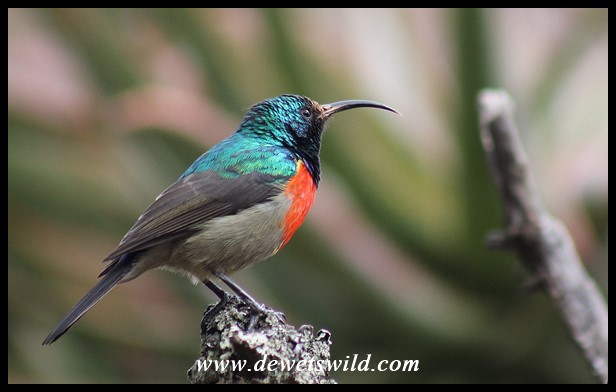Cinnyris afer
The Greater Double-collared Sunbird occurs only in South Africa and Swaziland, inhabiting high-lying shrublands, fynbos, forest margins, riverine woodland and parks and gardens, often in hilly and mountainous terrain. They feed on nectar, juicy fruits and insects and spiders. Adults measure 14cm in length and weigh around 15g.
Thse sunbirds are usually seen singly or in pairs. Breeding in the Greater Double-collared Sunbird has been recorded throughout the year, though there’s a distinct peak in the spring and summer months. Pairs are monogamous and very defensive of the immediate vicinity of their nest. The female is responsible for constructing the oval nest in dense trees using grass and other plant material bound with spider webs, lining the inside with fur and feathers. The female is also responsible for the incubation of the clutch of 2 eggs over a 2 week period, but both parents provide food to the hatchlings in the nest. The chicks leave the nest when they’re about two weeks old and stay with their parents for only another 10 days or so afterwards. Pairs may raise up to 3 broods in a season.
The IUCN evaluates the Greater Double-collared Sunbird as being of least concern.






















How industrious of them to raise up to three broods in a season! No wonder we see them eating insects and spiders regularly in addition to visiting flowers for nectar.
LikeLiked by 1 person
They’re always hurriedly busy foraging, and now we know why!
LikeLiked by 1 person
I think if I ever saw one of these I would assume it was a hummingbird. It certainly reminds me of them – although I suspect it’s a bit larger. Love the photo of the male hovering over the shrub.
LikeLike
You are quite right about the resemblance, Joanne, both in form and function, though interestingly hummingbirds and sunbirds are not closely related at all – rather a good example of convergent evolution to use the same ecological niche.
LikeLiked by 1 person
Te oulik…
LikeLiked by 1 person
Dit is hulle beslis, Tina
LikeLike
Great photos of a very handsome bird!
LikeLiked by 1 person
Thank you very much, Hien!
LikeLike
Great picture on the beautiful bird.😊 The Swedish name of the bird is South African Sunbird.
LikeLiked by 1 person
Thanks John – that’s a very good name for it, considering that it occurs only here at the southern end of the continent!
LikeLiked by 1 person
What a great collection of photos of that delightful little bird, Dries. As I scrolled through, I could see how well camouflaged they would be against the bright flowers.
LikeLiked by 1 person
Especially so the females, Tracy. The iridescent plumage of the males make camouflage a little trickier. And then their noisy contact calls often betray their presence longs before you have them in your sights.
LikeLiked by 1 person
What is it about nectar-feeding birds! They are always so noisy. 🙂
LikeLiked by 1 person
Drunk on all that sugar, I’d think! 😀
LikeLiked by 1 person
🙂
LikeLiked by 1 person
Beautiful birds! A pair of them reside in our garden and are regular visitors to the aloes, canary creeper, and the Cape Chestnut as well as catching butterflies on the wing.
LikeLiked by 1 person
Again the idea of receiving paying visitors to Anne’s Nature Reserve pops into my head – all you still need in your garden is a hide overlooking a pond, Anne, and your garden will become Grahamstown’s most famous destination!
LikeLike
You are very kind. Our garden has become a forested area over the years, both by design and benign neglect – a haven for birds, but this does not make for easy photography of its denizens!
LikeLiked by 1 person
And thus a well-located photographic hide is just the enhancement your garden needs, Anne!
All jokes aside, you can really be proud of the way you garden hand-in-hand with nature.
LikeLiked by 1 person
You post the most interesting things! I love it!
LikeLiked by 1 person
Wonderful to know that, Robert – thanks for the feedback!
LikeLiked by 1 person
That is some beak they have!
LikeLiked by 1 person
All the better to suck that nectar, Lois!
LikeLiked by 1 person